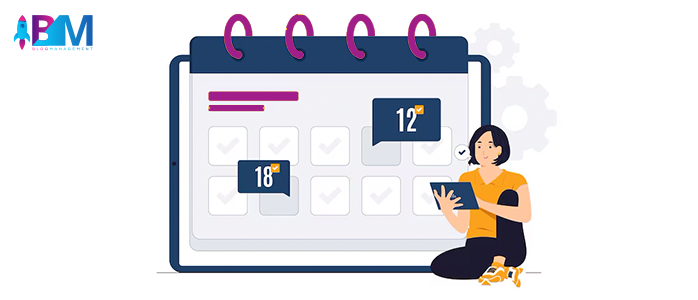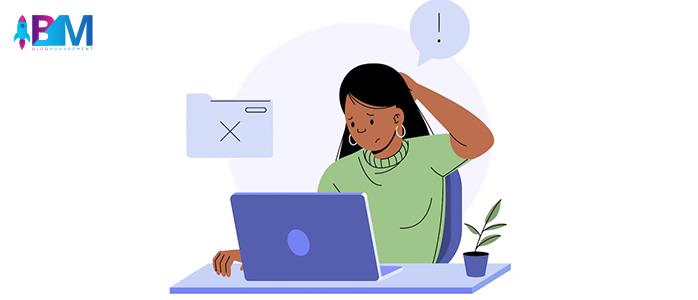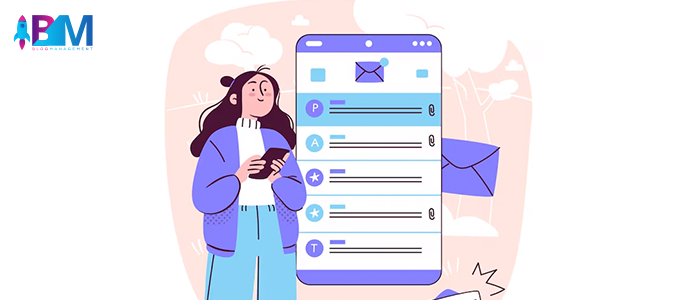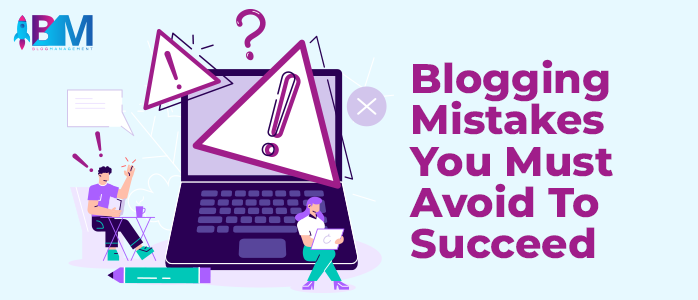There was a time when blogging was just about sharing ideas and building a small community of your own. However, now, it has become a smart way to build your brand, drive traffic, and grow your business too – if you have one. Even if a single blog post, if you write it beautifully, it can open doors to new opportunities and loyal audiences.
But… there’s a catch.
Many bloggers usually give up before reaching that point. They pour in the effort, spend hours and hours writing, and still… nothing. Why? Because of a few blogging mistakes that they probably have let creep in into their habit.
The truth is – even seasoned bloggers fall into traps from time to time. But as long as you know these ten common blogging mistakes and learn how to fix them, you’ll be fine.
So, let’s talk about them.
Mistake 1: Ignoring Your Audience

A: The Mistake
So, you’re writing great content and putting in a lot of effort – adding stats, using metaphors, and whatnot. But if you don’t know who you are writing for, it doesn’t matter how well-crafted the post is – no one will read it.
Writing without having a clear understanding of your audience is similar to shooting in the dark. Yes, you might get a few hits and traffic along the line. But the content won’t connect with the readers and won’t help with conversions as well.
B: The Solution
Know who you’re talking to, understand their pain points, and solve them through your blog. If you are struggling with ideation, creating a simple reader persona can also be helpful. Ask yourself the following three questions –
- What are your audiences’ goals?
- What’s keeping them up at night?
- What kind of language might they be using?
Once you’ve figured that out, tailor your blog content accordingly and answer their doubts. Remember, you’re writing the blog for someone to help them and make them feel seen.
Mistake – 2: Inconsistent Posting Schedule

A: The Mistake
You’ve posted an article today. So, when are you going to post the next one? Maybe next week? Or maybe two months later – who knows? While it might not seem too serious at first, this kind of inconsistency is a red flag for both readers and search engines.
And among the other blogging mistakes out there, this is the only one that quietly drains the momentum, too.
People love reliability. They want to know when to expect something new. If you vanish for weeks, they’ll move on. And when you return, it’ll be like starting from scratch. Again.
B: The Solution
Get organized. That’s it.
To make things easier, you can always start by creating a basic content calendar on a Google sheet. Decide how often you want to post (once a week or twice a month) and then stick to it.
Remember, consistency is one of the best blogging practices that builds trust over time. It also helps you stay focused, measure your performance better, and avoid that ‘wow, it’s been three weeks’ panic. So, the bottom line – aim for something sustainable and show up!
Mistake – 3: Writing without A Clear Purpose

A: The Mistake
You write, hit publish… and hope for the best. But did you wonder what the goal of that blog post was? Was it meant to drive more traffic to your website? Or did you want to rank higher on Google and build trust? If you’re not sure about what you’ve done, your audience won’t be either. This is one of the sneaky blogging mistakes that often gets overlooked – until your blog starts feeling like a scattered mess, with no direction or impact whatsoever.
B: The Solution
Before you start writing the article, always ask yourself – ‘why am I doing this?’ Maybe you’re trying to educate your audience or convert a casual reader into a newsletter subscriber.
Once the goal is clear, it will also be easier for you to shape the content around it. If you’re working with blog management services, they’ll often map this out for you. But if you are flying solo, take a few minutes to define the purpose. It makes a world of difference.
Mistake – 4: Neglecting SEO Best Practices

A: The Mistake
You’ve written something valuable, it reads well, and the layout looks pretty sharp as well. However, no one can find it on the internet, because you skipped the basics of SEO. You didn’t do any keyword research and didn’t provide any meta tags or internal links anywhere.
Without SEO, even your best content might stay hidden. It’s like setting up a shop in the middle of a desert – no one’s passing by to notice it.
B: The Solution
SEO doesn’t have to be too research-heavy or overly technical. You can always start simple by:
- Use a free keyword tool (like Google Trends) and use some specific keywords on your blog. This will help Google’s bots understand your content and rank it on the search engine when someone searches using relevant terms.
- Write short sentences and break the paragraph after writing two to three lines. This makes it easier for the readers (and search engine bots) to go through your content. The more people you get on your blog, the more authoritative it will seem to Google.
Also, if you have written posts on similar topics before, don’t forget to link them on relevant keywords too. This will create a content environment and prompt people to go through the same for hours and hours.
Adding some trustworthy external links will make your article look more truthful and written by an expert. This can be beneficial in terms of ranking, too.
Mistake – 5: Weak Or Boring Headlines

A: The Mistake
So, you’ve put in the hours and created a strong blog with clean visuals. And the advice or guide you have written is top-notch too. But the headline of the content says something like – ‘Tips for Blogging’ or ‘How to be Better at Writing.’ That’s not click-worthy at all.
Weak titles are the most damaging blogging mistakes because they create a bad impression. If your headline doesn’t spark curiosity or promise a benefit, people will scroll right past it.
B: The Solution
Make your headline do all the heavy lifting by focusing on clarity, curiosity, or a bold benefit – or ideally, all three. You can also use a tool like CoSchedule’s Headline Analyser to check if your topic’s title is good enough or not.
Also, don’t forget to use a number, a power word, and an emotional trigger if possible. A little drama isn’t really a bad thing if it grabs attention.
Mistake – 6: Poor Formatting And Readability

A: The Mistake
You have found a blog with whatever information you’re looking for and are pretty excited to read it. But after you clicked on the website, all you could see was a giant wall of text – no breaks, no headings, no breathing room, nothing. You probably won’t even read the first paragraph.
This might happen in your case as well. What you have written might be valuable for the readers. But if the formatting makes the reader squint or scroll away, then what’s the point?
B: The Solution
Structure matters much more than you think. So, in order to improve it –
- Use short paragraphs while writing (two to three lines maximum)
- Add some subheadings to guide the readers
- Throw in some bullet points for listing purposes
- Break up sections with graphics, images, and quotes
These small blog formatting tips can boost engagement and make your blog feel easier to digest. Even adding a bit of white space helps the eye move smoothly across the page.
Also, keep in mind – readability isn’t just for humans. It also makes your article seem of high quality to search engines. And hey, you’ve worked really hard on your blog – so, make sure that the intended people are actually reading it.
Mistake – 7: Over-Promotion Or Being Too Salesy

A: The Mistake
No one likes seeing that something is being sold to them all the time. If every blog post is just a pitch disguised as content, readers won’t stick around for long. Like… sure, selling is a part of the game. You have to make your audience notice what you are offering. However, if you are skipping the value of information and jumping straight to the sales talk – you’ll lose trust. And once that’s gone, it’s almost impossible to win it back.
B: The Solution
Making your blog sound less salesy but also offering some insights on what you offer can be done through the 80%-20% rule. So, 80% of your content should include pure value – answers, stories, insights, how-tos, etc. The other 20% is where you’re going to mention your product or service without “shouting” about it.
Subtle promotion usually works better in this context. You have to teach people about your product first before you sell it to them. This balance shows readers that you care more about helping them rather than hustling your way around.
You’ll build trust – and conversions – over time. Avoid this common trap, and you’ll already be ahead of many others making the same blogging mistakes.
Mistake – 8: Not Promoting Your Blog Content

A: The Mistake
You hit “publish” on a well-written blog post… and then just wait. Days go by, maybe weeks, and nothing happens. No traffic, no comments, no shares. Sound familiar?
This is one of the common blogging mistakes – assuming great content will magically promote itself. It won’t. Even the best-written blog can get buried if no one knows it exists.
B: The Solution
You have to spread the word and let the world know that you have something in store for them. Share your posts across different social platforms – LinkedIn, X (formerly Twitter), Facebook groups, and even Reddit or Quora if it fits.
If you have an email list, you can also try sending it there. You may also turn your blog into carousels, videos, or quick reels to reach new people in fresh ways.
Mistake – 9: Ignoring Analytics And Feedback

A: The Mistake
Writing blog after blog without checking what’s working and what’s not is like driving through a busy street with your eyes closed. Seriously, though – how do you know what your readers love (or hate) about your write-ups if you are not paying attention?
Many bloggers, like you, are pouring their heart and energy into the content they are creating. But they end up forgetting to measure results or listen to their audience. This leads to wasted time and missed opportunities, especially if your goal is to convert.
B: The Solution
Use tools like Google Analytics to track traffic on your website, its bounce rate, and time on page. Platforms like Hotjar also allow you to check how users are interacting with your blog – where they’re scrolling, clicking, or dropping off.
Oh, and we’ll also ask you not to ignore direct feedback at all. If someone is commenting on your posts, it becomes your duty to reply to them. Your readers are basically telling you what they like and don’t like about your blogs. That’s fuel for improvement.
Mistake – 10: Failing To Build An Email List

A: The Mistake
A lot of bloggers wait way too long before thinking about creating an email list. It’s okay if you are focusing too much on getting traffic. But don’t forget that most visitors – once they leave your website, they’ll never come back to it again… unless you give them a reason to.
Not capturing emails means you’re missing out on direct, long-term engagement. No matter how great your blog is, if you’re not staying in touch, you’re losing potential loyal readers.
B: The Solution
So, it’s important to start growing your list from day one. For that, you can try offering lead magnets, such as eBooks, templates, or checklists, in exchange for the reader’s email.
We’d also suggest you add an opt-in form in your post, sidebar, or through a polite pop-up to make it easier for everyone to subscribe.
The Bottom Line
Blogging isn’t a success story you’re going to achieve overnight. It will take a lot of time, effort, and a whole lot of patience. But if you can sidestep the common blogging mistakes we have mentioned here, you’re already ahead of the game.
So, focus on consistency. Keep learning as you go. And most importantly, always, always, put your audience first. Your blog isn’t just a platform; it’s a conversation. So keep showing up, keep adding value, and watch your blog evolve into something powerful.
